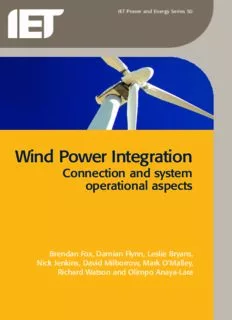Table Of ContentIET Power and Energy Series 50
Wind Power Integration
Connection and system
operational aspects
Brendan Fox, Damian Flynn, Leslie Bryans,
Nick Jenkins, David Milborrow, Mark O’Malley,
Richard Watson and Olimpo Anaya-Lara
IETPOWERANDENERGYSERIES50
Wind Power Integration
Wind Power Integration
Connection and system
operational aspects
Brendan Fox, Damian Flynn, Leslie Bryans,
Nick Jenkins, David Milborrow, Mark O’Malley,
Richard Watson and Olimpo Anaya-Lara
TheInstitutionofEngineeringandTechnology
PublishedbyTheInstitutionofEngineeringandTechnology,London,UnitedKingdom
©2007TheInstitutionofEngineeringandTechnology
Firstpublished2007
ThispublicationiscopyrightundertheBerneConventionandtheUniversalCopyright
Convention.Allrightsreserved.Apartfromanyfairdealingforthepurposesofresearch
orprivatestudy,orcriticismorreview,aspermittedundertheCopyright,Designsand
PatentsAct,1988,thispublicationmaybereproduced,storedortransmitted,inany
formsorbyanymeans,onlywiththepriorpermissioninwritingofthepublishers,orin
thecaseofreprographicreproductioninaccordancewiththetermsoflicencesissued
bytheCopyrightLicensingAgency.Inquiriesconcerningreproductionoutsidethose
termsshouldbesenttothepublishersattheundermentionedaddress:
TheInstitutionofEngineeringandTechnology
MichaelFaradayHouse
SixHillsWay,Stevenage
Herts,SG12AY,UnitedKingdom
www.theiet.org
Whiletheauthorandthepublishersbelievethattheinformationandguidancegivenin
thisworkarecorrect,allpartiesmustrelyupontheirownskillandjudgmentwhen
makinguseofthem.Neithertheauthornorthepublishersassumeanyliabilityto
anyoneforanylossordamagecausedbyanyerrororomissioninthework,whether
sucherrororomissionistheresultofnegligenceoranyothercause.Anyandallsuch
liabilityisdisclaimed.
Themoralrightsoftheauthorstobeidentifiedasauthorsofthisworkhavebeen
assertedbytheminaccordancewiththeCopyright,DesignsandPatentsAct1988.
BritishLibraryCataloguinginPublicationData
Windpowerintegration:connectionandsystemoperationalaspects
1.Windpower
I.Fox,BendanII.InstitutionofElectricalEngineers
621.3’12136
ISBN978-0-86341-449-7
TypesetinIndiabyNewgenImagingSystems(P)Ltd,Chennai
PrintedintheUKbyMPGBooksLtd,Bodmin,Cornwall
Othervolumesinthisseries:
Volume1 PowercircuitbreakertheoryanddesignC.H.Flurscheim(Editor)
Volume4 IndustrialmicrowaveheatingA.C.MetaxasandR.J.Meredith
Volume7 InsulatorsforhighvoltagesJ.S.T.Looms
Volume8 VariablefrequencyAC-motordrivesystemsD.Finney
Volume10 SF6switchgearH.M.RyanandG.R.Jones
Volume11 ConductionandinductionheatingE.J.Davies
Volume13 StatisticaltechnjiquesforhighvoltageengineeringW.Hauschildand
W.Mosch
Volume14 UninterruptiblepowersuppliesJ.PlattsandJ.D.StAubyn(Editors)
Volume15 DigitalprotectionforpowersystemsA.T.JohnsandS.K.Salman
Volume16 ElectricityeconomicsandplanningT.W.Berrie
Volume18 VacuumswitchgearA.Greenwood
Volume19 Electricalsafety:aguidetocausesandpreventionofhazards
J.MaxwellAdams
Volume21 Electricitydistributionnetworkdesign,2ndeditionE.Lakerviand
E.J.Holmes
Volume22 ArtificialintelligencetechniquesinpowersystemsK.Warwick,
A.O.EkwueandR.Aggarwal(Editors)
Volume24 PowersystemcommissioningandmaintenancepracticeK.Harker
Volume25 Engineers’handbookofindustrialmicrowaveheatingR.J.Meredith
Volume26 SmallelectricmotorsH.Moczalaetal.
Volume27 AC-DCpowersystemanalysisJ.ArrillagaandB.C.Smith
Volume29 Highvoltagedirectcurrenttransmission,2ndeditionJ.Arrillaga
Volume30 FlexibleACTransmissionSystems(FACTS)Y-H.Song(Editor)
Volume31 EmbeddedgenerationN.Jenkinsetal.
Volume32 Highvoltageengineeringandtesting,2ndeditionH.M.Ryan(Editor)
Volume33 Overvoltageprotectionoflow-voltagesystems,revisededitionP.Hasse
Volume34 ThelightingflashV.Cooray
Volume35 ControltechniquesdrivesandcontrolshandbookW.Drury(Editor)
Volume36 VoltagequalityinelectricalpowersystemsJ.Schlabbachetal.
Volume37 ElectricalsteelsforrotatingmachinesP.Beckley
Volume38 Theelectriccar:developmentandfutureofbattery,hybridand
fuel-cellcarsM.Westbrook
Volume39 PowersystemsofelectromagnetictransientssimulationJ.Arrillagaand
N.Watson
Volume40 AdvancesinhighvoltageengineeringM.HaddadandD.Warne
Volume41 ElectricaloperationofelectrostaticprecipitatorsK.Parker
Volume43 ThermalpowerplantsimulationandcontrolD.Flynn
Volume44 Economicevaluationofprojectsintheelectricitysupplyindustry
H.Khatib
Volume45 PropulsionsystemsforhybridvehiclesJ.Miller
Volume46 DistributionswitchgearS.Stewart
Volume47 Protectionofelectricitydistributionnetworks,2ndeditionJ.Gersand
E.Holmes
Volume48 WoodpoleoverheadlinesB.Wareing
Volume49 Electricfuses,3rdeditionA.WrightandG.Newbery
Volume50 WindpowerintegrationB.Foxetal.
Volume51 ShortcircuitcurrentsJ.Schlabbach
Volume52 NuclearpowerJ.Wood
Volume905 Powersystemprotection,4volumes
Contents
Preface ix
Listofacronyms xi
1 Introduction 1
1.1 Overview 1
1.2 Worldenergyandclimatechange 2
1.2.1 Renewableenergy 2
1.3 Windenergy 4
1.3.1 Background 4
1.3.2 Changesinsizeandoutput 5
1.3.3 Energyproductivity 6
1.4 Designoptions 7
1.4.1 Blades 7
1.4.2 Controlandthepowertrain 8
1.4.3 Summaryofprincipaldesignoptions 8
1.5 Windfarms 9
1.5.1 Offshorewind 10
1.6 Economics 11
1.6.1 Windturbineprices 11
1.6.2 Electricity-generatingcosts 11
1.6.3 Carbondioxidesavings 12
1.7 Integrationandvariability:keyissues 14
1.7.1 Windfluctuations 14
1.7.2 Capacitycredits 16
1.7.3 Embeddedgenerationbenefits 17
1.7.4 Storage 17
1.8 Futuredevelopments 18
1.8.1 Technology 18
1.8.2 Futurepricetrends 18
vi Contents
1.8.3 Marketgrowth 19
1.8.4 Integrationissues 19
2 Powersystemfundamentals 21
2.1 Introduction 21
2.2 Basicprinciples 21
2.2.1 Electromagnetism 21
2.2.2 Magneticcircuits 24
2.2.3 Electromagneticinduction 25
2.2.4 Electricitysupply 25
2.2.5 Thetransformer 26
2.3 ACpowersupply 28
2.3.1 Powerinsteady-stateACsystems 28
2.3.2 Phasors 30
2.3.3 PowerinACsystems 33
2.4 Introductiontopowersystems 34
2.4.1 Three-phasesystems 34
2.4.2 Comparisonofsingle-andthree-phasesystems 35
2.4.3 Three-phasesupply 36
2.4.4 Balancedstar-connectedload 37
2.4.5 Balanceddelta-connectedload 38
2.4.6 Someusefulconventions 39
2.4.7 ThecomplexVAproduct 40
2.4.8 Equivalentsingle-phase 41
2.4.9 Theperunitsystem 41
2.5 Powertransmission 44
2.5.1 Lineparameters 44
2.5.2 Linemodels 47
2.5.3 Powertransmission 49
2.5.4 Voltageregulation 49
3 Windpowertechnology 53
3.1 Introduction 53
3.2 Historicalreviewofwindpowertechnology 53
3.3 Designchoicesforlargewindturbinegenerators 55
3.4 Energyextractionandpowerregulation 56
3.4.1 Energyextractionacrosstherotordisc 56
3.4.2 Powerregulation 60
3.5 Fixed-speedwindturbines 64
3.5.1 Reviewoftheinduction(asynchronous)machine 64
3.5.2 Fixed-speedinductiongenerator-basedwindturbine 69
3.6 Variable-speedwindturbines 72
3.6.1 DFIGwindturbine 73
3.6.2 Wide-rangevariable-speedsynchronousgeneratorwind
turbine 77
Contents vii
4 Networkintegrationofwindpower 87
4.1 Introduction 87
4.2 Windfarmstarting 87
4.3 Networkvoltagemanagement 89
4.3.1 Thevoltagelevelissue 89
4.4 Thermal/activepowermanagement 103
4.4.1 Planningapproaches/standards 103
4.4.2 Windfarmconnectionissues 104
4.4.3 Backbonesystemissues 105
4.4.4 Equipmentissues 107
4.5 Networkpowerqualitymanagement 108
4.5.1 Dips 108
4.5.2 Harmonics 108
4.5.3 Flicker 109
4.6 Transientsystemperformance 109
4.6.1 Frequencyperformanceanddynamicresponse 109
4.6.2 Transientresponse 111
4.7 Faultlevelissues 117
4.7.1 Equipmentcapability 117
4.8 Information 119
4.9 Protection 119
4.9.1 Systemprotection 119
4.9.2 Transmissionconnectedwindfarms 120
4.9.3 Distributionconnectedwindfarms 122
4.9.4 Windfarmprotection 124
5 Operationofpowersystems 127
5.1 Introduction 127
5.2 Load-frequencycontrol 128
5.2.1 Unitload-frequencycontrol 132
5.2.2 Emergencyfrequencycontrol 135
5.3 Systemoperationwithwindpower 140
5.3.1 Overviewofsystemoperationalchallengesofwind
power 140
5.3.2 WindpowerinIreland 143
5.3.3 Systemoperationandwindvariability 158
5.3.4 Systemoperationalmodes 169
5.3.5 Capacitycredit 177
5.3.6 Ancillaryserviceprovision 180
5.3.7 Windturbinegeneratorinertialresponse 189
5.3.8 Distributedgenerationprotection 192
5.4 Energystorage/flexibleloadmanagement 195
5.4.1 Conventionalenergystorage 197
5.4.2 Demand-sidemanagement 200
5.4.3 Hydrogenenergystorage 202
viii Contents
6 Windpowerforecasting 209
6.1 Introduction 209
6.2 Meteorologicalbackground 210
6.2.1 Meteorology,weatherandclimate 210
6.2.2 Atmosphericstructureandscales 211
6.3 Numericalweatherprediction 212
6.4 Persistenceforecasting 214
6.4.1 Errormeasures 215
6.4.2 Referencemodels 216
6.5 Advancedwindpowerforecastingsystems 222
6.5.1 Prediktor 226
6.5.2 Statisticalmodels 230
6.5.3 Ensembleforecasting 235
6.6 Conclusions 236
7 Windpowerandelectricitymarkets 239
7.1 Introduction 239
7.2 Theelectricalenergymarket 241
7.3 Balancing,capacityandancillaryservices 243
7.4 Supportmechanisms 245
7.5 Costs 246
7.6 Investmentandrisk 249
7.7 Thefuture 250
Appendix:FACTStechnology 253
References 259
Index 269
Preface
The impetus for the book is the rapid growth of wind power and the implications of
this for future power system planning, operation and control. This would have been a
considerable challenge for the vertically integrated power companies pre-1990. It has
become an even greater challenge in today’s liberalised electricity market conditions.
The aim of the book is to examine the main problems of wind power integration on a
significantscale.Theauthorsthendrawontheirknowledgeandexpertisetohelpguide
thereaderthroughanumberofsolutionsbasedoncurrentresearchandonoperational
experienceofwindpowerintegrationtodate.
The book’s backdrop was the commitment of the UK government (and European
governments generally) to a target of 10 per cent of electrical energy from renewable
energy sources by 2010, and an ‘aspirational goal’ of 20 per cent by 2020. There has
alsobeenasignificantreductioninthecostofwindpowerplant,andhenceenergycost.
Whereaveragewindspeedsare8m/sormore,asisthecaseformuchofGreatBritainand
Ireland, thebasicproductioncostofwindenergyisnearlycompetitivewithelectricity
from combined cycle gas turbine (CCGT) plant, without the concern about long-term
availabilityandcost.Thedownsideisthatthesupplyoverthesystemoperationaltime-
scaleisdifficulttopredict.Inanycase,windpowercannotprovide‘firmcapacity’,and
thereforesufferscommerciallyinmarketssuchasBETTA(Britishelectricitytradingand
transmissionarrangements).Ontheotherhand,greenincentivesintheformofrenewable
obligationcertificates(ROCs)providewindgeneratorswithasignificantextraincome.
This is encouraging developers to come forward in numbers which suggest that the
10 per cent target may be attained. Indeed, Germany, Spain and Ireland are already
experiencingwindenergypenetrationlevelsintheregionof5percent,whileDenmark
reachedalevelof20percentsomeyearsago.
Thebookattemptstoprovideasolidgroundinginallsignificantaspectsofwindpower
integrationforengineersinavarietyofdisciplines.Thusamechanicalengineerwilllearn
sufficientelectricalpowerengineeringtounderstandwindfarmvoltageregulationand
faultride-throughproblems;whileanelectricalengineerwillbenefitfromthetreatment
of wind turbine aerodynamics. They will both wish to understand electricity markets,
andinparticularhowwindenergyislikelytofare.
Theintroductorychapterchartstheremarkablegrowthofwindenergysince1990.
Thevarioustechnicaloptionsforwindpowerextractionareoutlined.Thischapterthen
Description:The rapid growth of wind power and the implications of this on future power system planning, operation and control has become an even greater challenge in today's liberated electricity market conditions. This essential new book examines the main problems of wind power integration and guides the read

